Climate changes during the past 31 years and their contribution to the changes in the productivity of rangeland vegetation in the Inner Mongolian typical steppe
Xinhong Wu A , Peng Li A , Chao Jiang A , Pengtao Liu B , Jing He A and Xiangyang Hou A CA Institute of Grassland Research, Chinese Academy of Agricultural Sciences, Hohhot 010010, P.R. China.
B Remote Sensing Centre of the Meteorological Bureau in Inner Mongolia, Hohhot 010010, P.R. China.
C Corresponding author. Email: Houxy16@126.com
The Rangeland Journal 36(6) 519-526 https://doi.org/10.1071/RJ14054
Submitted: 14 May 2013 Accepted: 4 November 2014 Published: 5 December 2014
Journal Compilation © Australian Rangeland Society 2014
Abstract
The objectives of this study were to explore the impact of climate change and human activities on the annual production of aboveground biomass of vegetation during the past 31 years at a county scale in the typical steppe region of Inner Mongolia. The changes in three banners in the region (Abag Banner, Xilinhaote City, and Xiwuzhumuqin Banner) were analysed. The changes in the annual potential grassland production (net primary productivity) and in the annual production of vegetation, as the sum of aboveground biomass and consumption by livestock, were estimated for each year. A comparison of the changing rates in net primary productivity and aboveground biomass of vegetation over the 31 years was used to distinguish the effects of climate change on grassland production from human activities. The results showed that the climate had become warmer and drier during the past 31 years and thus net primary productivity and annual production of vegetation decreased significantly. Climate change was a major factor for these decreases, while human activities were a minor factor in the decrease of grassland production in Xuwuzhumuqi Banner. The importance of human activities in reducing this decrease in grassland production during the last 31 years is in accordance with the changes in grassland-use policy that has encouraged destocking for grassland restoration in recent years.
Additional keywords: livestock consumption, net primary productivity, remote sensing, total grassland production.
Introduction
Research on the effects of climate change on terrestrial ecosystems is still in the early stages, and most work to date has concentrated on forest and farmland ecological systems. Similar studies on grassland ecosystems are becoming more common together with the development of adaptive management strategies (Parton et al. 1995; Li et al. 2003; Peñuelas 2009; Steltzer and Post 2009; Kardol et al. 2010; Ma et al. 2010; Walther 2010; Wang and Shi 2010). Yin et al. (2011) has described some of these changes in northern China at the 41°07ʹ northern latitude but further investigations are necessary in order to better understand the processes involved. These studies to date have mostly concerned the effects of rainfall, temperature and their interactions (Gao et al. 1996; Xiao et al. 1996; Wang et al. 2000; Zhou et al. 2000, 2002, 2012; Gao et al. 2003; Chuluun and Ojima 2012). However, there are very few reports about the use of grassland management models. Using the Savanna Model, Christensen et al. (2003) simulated the relationships among climate change, vegetation, and grazing ecology system at 14 stocking rates in the Inner Mongolian typical steppe. More recently, Tietjen and Jeltsch (2007) examined the potential of 71 grassland ecosystem models to better understand the relationship between grazing and grassland ecology.
Climate change and human activities interactively affect grassland productivity depending on the climate, topography and the types of land use in a region. To separate and understand the effects of these two drivers has been the focus of much recent attention in ecological and environmental science. The normalised difference vegetation index (NDVI) statistics model has been used to calculate the influences of climate change and human activities (Evans and Geerken 2004; Sun et al. 2008). However, most studies have been at a regional scale (Liang et al. 2002) and there have been few studies at a smaller scale, such as a county, which is more pertinent for grassland management. The objective of this study was to estimate the relative contributions of climate change and human activities on primary productivity of grasslands at a county scale in the typical steppe region of Inner Mongolia.
Materials and methods
Study area
Perennial bunch grasses are the dominant vegetation in the typical steppe region of Inner Mongolia, China. Shrub and semi-shrub vegetation are also present but at lower levels of cover (Chen and Wang 2000).
The study area extended across 43°04ʹ–45°26ʹN and 113°27ʹ–119°22ʹE and was administrated by three adjacent banners (Abag, Xilinhaote, and Xiwuzhumuqin). Xilinhaote is a banner-level city, so is included as a banner in this study. The rainfall increases from the relatively dry west to the moist east in the Xilingol region of Inner Monoglia. The total area is 65 357 km2, of which ~61 101 km2 are covered with grasslands of the typical steppe (Tong and Liu 1992). The mean annual precipitation varied between 244 and 345 mm, and annual mean temperature was 0.7–3.0°C and mean annual evaporation was 1500–2360 mm. The landscape consists of a high plain, low mountains and hills, dunes and sandy land, with elevation ranging from 1000 to 1400 m above sea level. The soil types include the castanozems, chernozems, aeolian sandy soils, grey meadow soils, and grey forest soils. The vegetation is mainly typical steppe, with small areas covered by meadow steppes, meadows and forest (Editorial Committee of Flora of Inner Mongolia 1994).
Experimental design
The changes in the annual production of vegetation in the three banners during the past 31 years were investigated. The annual production of vegetation was estimated as the amount of aboveground biomass plus the consumption of vegetation by grazing livestock in a year.
The effects of two factors, climate change and human activity, on the annual production of vegetation were studied using a NDVI statistical model (Evans and Geerken 2004; Sun et al. 2008).
Sources of data
Average daily climate data from three meteorological stations were obtained from the national meteorological database of China from 1981 to 2011 (Chinese Meteorological Database 2012). Remotely sensed data consisted of NDVI data (from 1981 to 2006) which were generated by using the advanced very high resolution radiometer (AVHRR) that belongs to the National Oceanic and Atmospheric Administration (NOAA) family of polar orbiting platforms and MODIS NDVI data (from 2000 to 2011). The NOAA/AVHRR satellite records provide discrete information for individual 8 × 8-km areas. The temporal resolution is 15 days. The spatial resolution of MODIS NDVI is 1 × 1 km. Data from the NOAA/AVHRR satellite and MODIS NDVI were converted into monthly NDVI data using the maximum value composite procedure (van Leeuwen et al. 1999). Statistics on the numbers of livestock were obtained from the numbers of livestock present every year in the three banners, and were converted into sheep units (Ministry of Agriculture of the People’s Republic of China 2002).
Description of variables used
Effective precipitation (P) is the sum of precipitation (p) from May to September (plant growing season); that is,

Mean annual daily temperature (BT) is the average of daily temperature (t) in every year (365 days) when 0 < t ≤ 30°C. The BT was calculated based on the following equation:

The aridity index (PER) describes the degree of dryness of the climate, and is the ratio of potential evaporation to precipitation. It was estimated by the CHIKUGO method (Zhou and Zhang 1996) according to the following equation:

The net primary production (NPP) is the amount of total organic matter produced by the vegetation during photosynthesis minus the amount of total organic matter the plants use during respiration. The NPP was calculated according to Eqn 5 given in Zhou and Zhang (1996). The unit is t MD ha–1.
The radiation index of dryness corresponds to the water budgets for each year. The radiation dryness index (RDI) was estimated from Eqn 4:


The annual production of vegetation (GP) of every banner was estimated as the sum of the aboveground biomass from the remote sensing data (YR) and the amount of grazing utilisation (YG) every year (Eqn 6). The unit is t DM ha–1.

YR was estimated using the MODIS model of Zhang et al. (2006) (Eqn 7). The accuracy of this model was estimated to be 97%.

where X is NDVI.
The images of MODIS and NOAA overlapped from 2000 to 2006. The YR from NOAA was calculated according to the following equation:

where X is NDVI.
The amount of grazing utilisation (YG) was calculated according to the following:

where U denotes the number of grazing livestock (sheep unit), G is the daily intake of a sheep unit [kg, dry matter (DM day–1)], D is the number of grazing days, and S (ha) represents the area of available grassland. Before 2002, the number of grazing days for all three banners were 92 days from mid-May to mid-August and after 2002, the number of grazing days were 62 days from mid-June to mid-August.
The contribution of the two factors, climate change and human activity, on the changes in GP were estimated according to the following equations (Li et al. 2011, 2012; Sun et al. 2012):



where VGP, VC and Vf represent the annual rates of changes in GP, in NPP (climate determined), and the rate of change induced by human activities. The contribution of climate change and human activity, expressed as percentages, were denoted by EC and Ef.
Data analyses
Statistical analyses were performed using SPSS version 13.0 and Microsoft Office Excel 2003. Analyses of general linear and curve linear models were used for ANOVA. Treatment means were compared to determine whether they were significantly different at P < 0.05.
Results
Changes in precipitation, temperature and climate aridity over the past 31 years
The mean values of total effective precipitation for the Abag Banner, Xinlinhaote City and Xiwuzhumuqin Banner were 204 ± 63 mm, 227 ± 77 mm and 281 ± 80 mm, respectively. The effective precipitation during the past 31 years showed no significant change in Abag Banner and Xinlinhaote City (P > 0.1) but showed a significant decline in Xiwuzhumuqin Banner (VP = –3.58 mm year–1, P < 0.01), (Fig. 1).
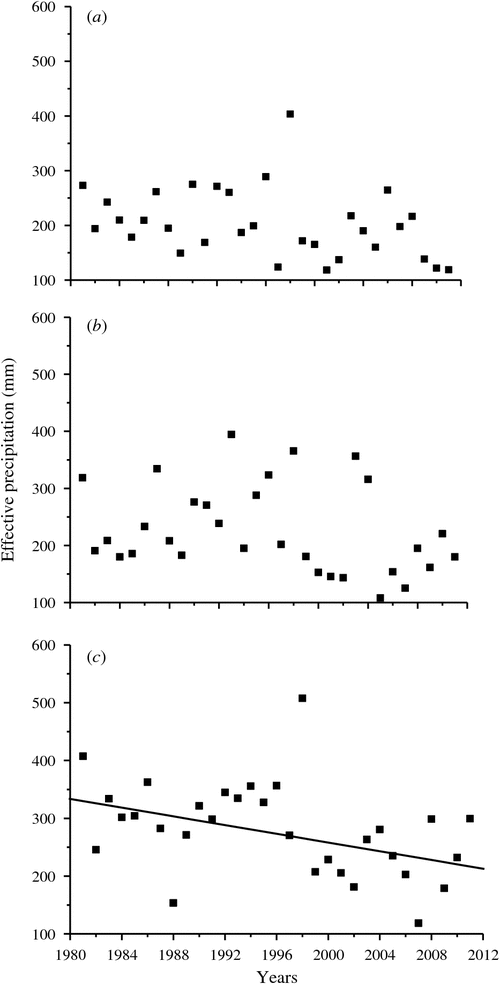
|
Mean annual daily temperatures (BT) of the Abag Banner, Xinlinhaote City and Xiwuzhumuqin Banner were 7.1 ± 0.41°C, 7.3 ± 0.37°C and 6.7 ± 0.35°C, respectively. Mean annual daily temperatures increased significantly in all three banners during the past 31 years (Fig. 2).
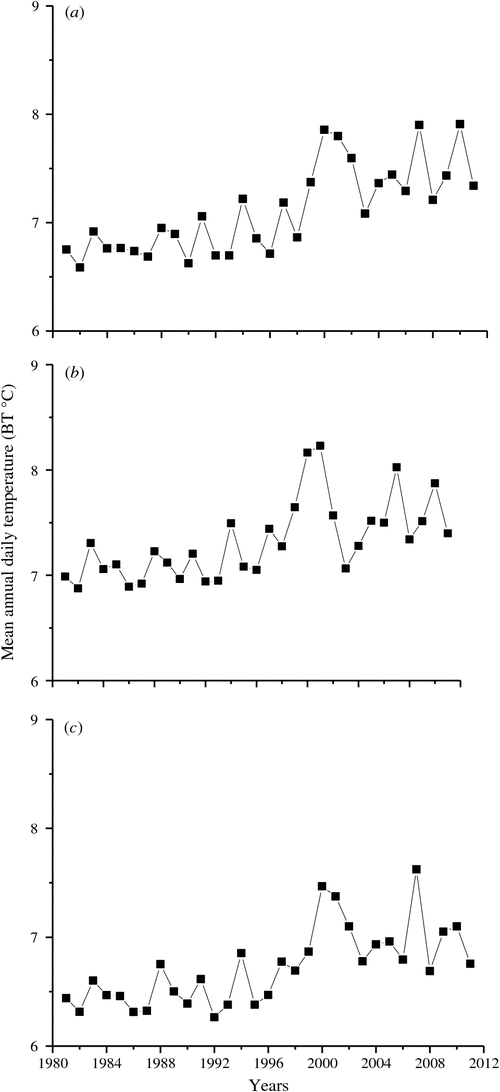
|
Annual PER values of the Abag Banner, Xinlinhaote City and Xiwuzhunmuqin Banner were 2.27 ± 0.77, 2.14 ± 0.79 and 1.56 ± 0.61, respectively. This index also showed a significant increase (P < 0.05) in all three banners during the past 31 years (Fig. 3).
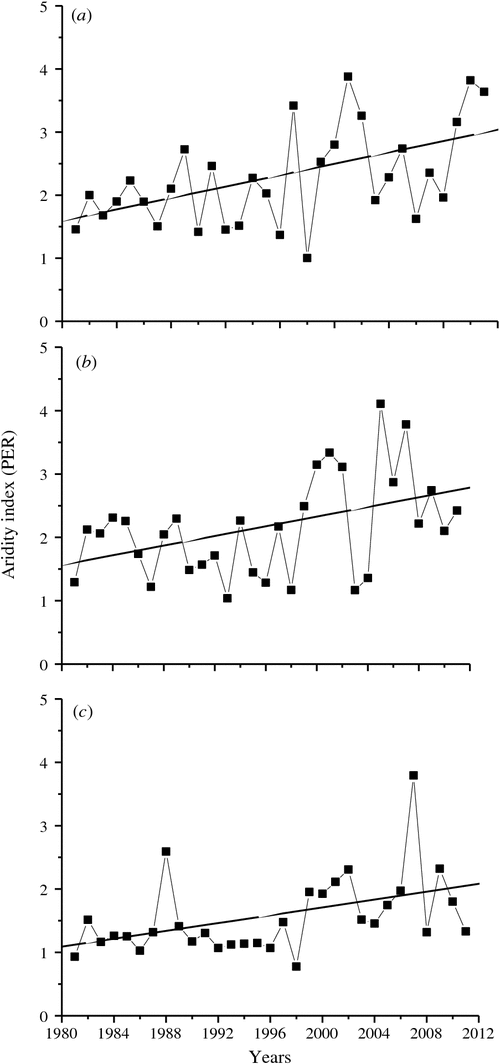
|
Changes in NPP over the past 31 years
Annual NPP values in the Abag Banner, Xinlinhaote City and Xiwuzhumuqin Banner were 2.95 ± 0.56 t ha–1, 3.17 ± 0.63 t ha–1 and 3.46 ± 0.49 t ha–1, respectively. There were significant decreases in NPP in all three banners during the past 31 years (Fig. 4); the annual percentage decreases (VNPP) were –0.023, –0.023, and –0.018, respectively, for Abag Banner, Xilinhaote City and Xiwuzhunmuqin Banner.
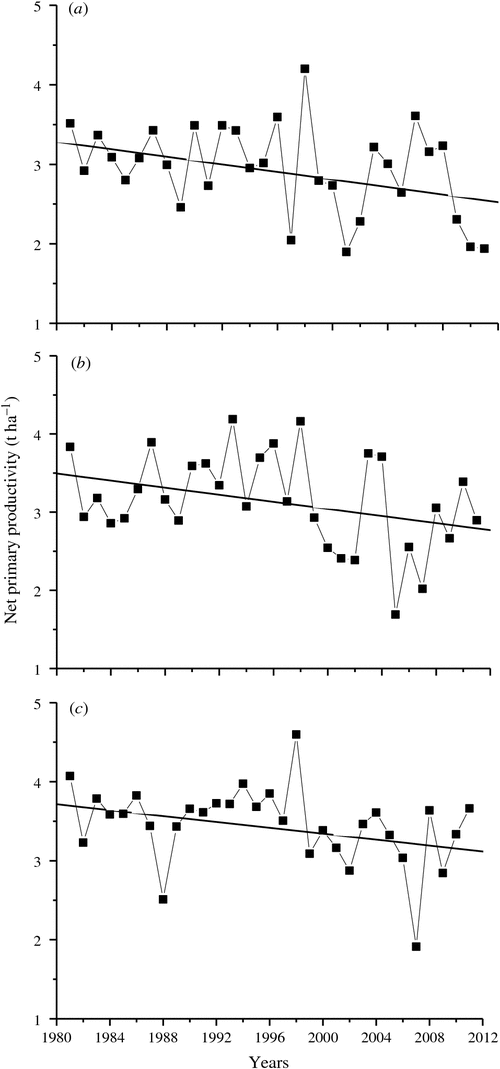
|
Changes in vegetation production and grazing utilisation of the rangelands over the past 31 years
Annual GP values of the Abag Banner, Xinlinhaote City and Xiwuzhumuqin Banner were 1.51 ± 0.23 t DM ha–1, 1.82 ± 0.32 t DM ha–1 and 2.28 ± 0.37 t DM ha–1, respectively. The GP values in the three banners declined during the 31-year period (Fig. 5); the percentage rates of decline (VGP) were –0.009, –0.014, and –0.022 in Abag Banner, Xinlinhaote City and Xiwuzhumuqin Banner, respectively.
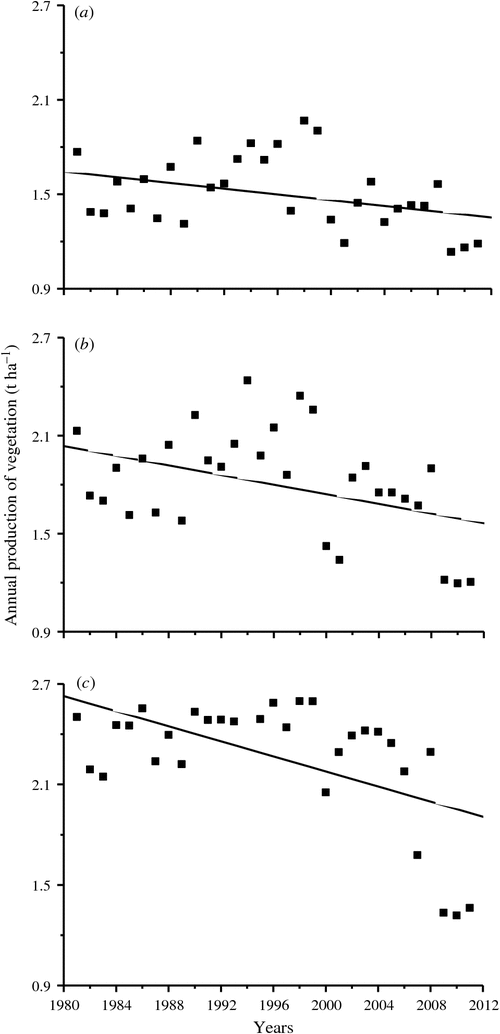
|
Annual YR values of the Abag Banner, Xinlinhaote City and Xiwu Banner were 1.38 ± 0.21 t DM ha–1, 1.65 ± 0.30 t DM ha–1 and 2.05 ± 0.32 t DM ha–1, respectively. The annual YR values in the three banners declined during the 31-year period (Fig. 6); the percentage rates of decline (VYR) were –0.008, –0.013, and –0.021 in Abag Banner, Xinlinhaote City and Xiwuzhumuqin Banner, respectively.
Annual YG values of the Abag Banner, Xinlinhaote City and Xiwu Banner were 0.14 ± 0.05 t ha–1, 0.17 ± 0.06 t ha–1 and 0.23 ± 0.08 t ha–1, respectively. The annual YG values in the three banners increased from 1981 to 1999 and then declined from 2000 to 2011 (Fig. 7); the percentage rates of increase (VYG) were 0.007, 0.010, and 0.011 in the Abag Banner, Xinlinhaote City and Xiwuzhumuqin Banner, respectively, and the percentage rates of decline (VYG) were –0.013, –0.013, and –0.024, respectively.
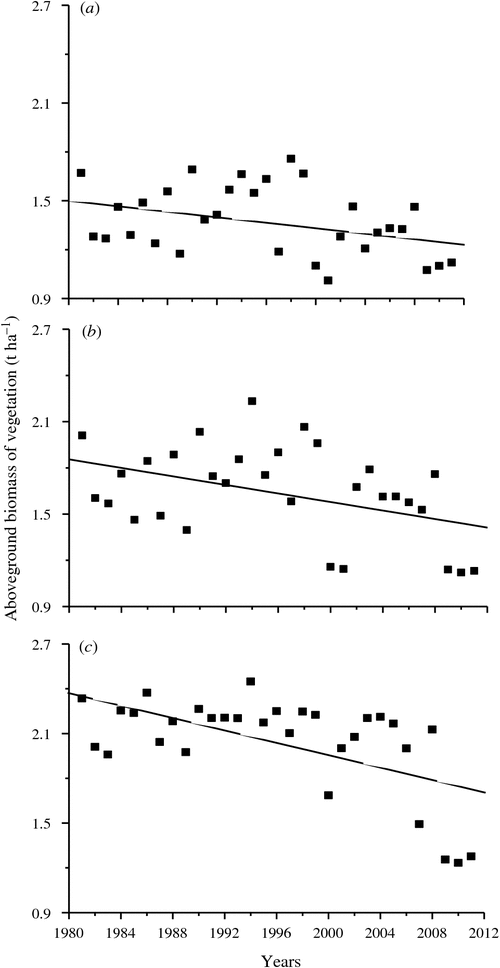
|
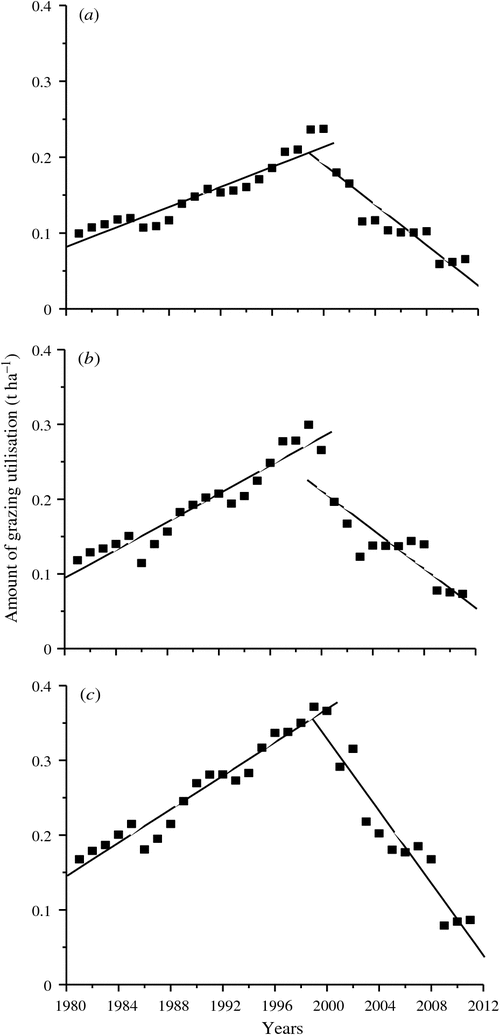
|
Contribution of climate change and human activity to vegetation production of rangelands over the past 31 years
The contribution (%) of climate change and human activity to productivity changes were calculated for the decrease in GP values over the 31-year period (Table 1). Both climate change and human activity significantly (P < 0.05) affected the GP in all three banners.

|
The contribution of climate change was higher (256%, 164%) in the Abag Banner and Xilinhaote City than in the Xiwuzhumuqin Banner (82%) (Table 1). The effect of human activities was much greater in reducing the productivity in the Abag Banner than in the other two banners (–156% compared with –64% and 18%, Table 1).
Discussion
The contributions (%) of climate change and human activity to productivity changes over the past 31 years were significantly different (P < 0.05) in terms of the degree of change and the trend in the three banners studied. Therefore, these results would have important practical implications for grassland management change and so it would be important to perform similar studies for larger regions of the county.
The important elements of the changed climate over the past 31 years in the three banners studied were the decreased annual average effective precipitation (P), the increased mean annual daily temperature (BT) and the consequent changes in the aridity index (PER). This has resulted in the boundaries of the desert steppe extending to the east, whereas the boundaries of the typical steppe have been compressed in the eastern part of its range (Niu 2001).
The NPP significantly decreased (P < 0.05) by 19%, although the annual production of vegetation (GP) decreased by 21%. The impact of climate change on the annual production of vegetation was very strongly negative, whereas the effect of human activity was significant (P < 0.05) and positive after 2000. This change indicated that a series of important ecological protection and improvement projects, such as returning land to pasture implemented after 2002, and controlling the sandstorms, implemented after 2003 in Inner Mongolia have been successful (Liu 2007). However, the fluctuations in the weather associated with climate change were also important in their effect on the annual production of vegetation.
Sun et al. (2012) and Li et al. (2011) used similar methods to calculate the contribution of climate change and human activity on vegetation growth during the desertification processes in the Three-River Headwaters region in China. However, the present paper is the first occasion in which this method has been used to investigate the contribution of climate change and human activities on the annual production of vegetation of grassland. The importance of human activities in reducing this decrease in grassland production during the past 31 years is in accordance with the changes in grassland use policy that have encouraged destocking for grassland restoration. In order to balance grassland restoration with the livestock grazing industry, the central government has invested more than 10 billlion RMB in grassland recovery including grass seed production, seedling establishment, grassland fencing, grazing bans on heavily degraded areas and sandstorm control from 2000 to 2007 (Liu et al. 2008). These projects have slowed down the degradation of the grasslands.
The equations for the NDVI statistics model are simpler than those for other models and fewer variables were used. The NDVI statistics model can clearly show the contributions of climate change and human activity on GP. Therefore, this method was selected in this paper. However, the resolution of the NOAA is lower than that of MODIS satellite, so that the effects of the other types of vegetation, such as farmland and forest, had not been eliminated in the data up until 2006. Using the higher resolution remote sensing data, it may be feasible to study in-depth and more accurately the relative contributions of climate change and human activity at the banner scale.
Acknowledgements
Research was funded by the National Key Basic Research Program of China (2014CB138802), a National Natural Science Foundation Grant of China (70933004), the Key Laboratory of Grassland Resources and Ecology, Ministry of Agriculture and Eurasian Temperate Steppe Research Centre of Chinese Academy of Agricultural Science.
References
Chen, Z. Z., and Wang, S. P. (2000). ‘Typical Steppe Ecosystem of China.’ (Science Press: Beijing, China.) [In Chinese]Chinese Meteorological Database (2012). Available at: http://cdc.cma.gov.cn/home.do (accessed 20 December 2012).
Christensen, L., Coughenour, M. B., Ellis, J. E., and Chen, Z. Z. (2003). Sustainability of Inner Mongolian grasslands: application of the Savanna model. Journal of Range Management 56, 319–327.
| Sustainability of Inner Mongolian grasslands: application of the Savanna model.Crossref | GoogleScholarGoogle Scholar |
Chuluun, T., and Ojima, D. (2012). Land-use change and carbon cycle in arid and semi-arid land of east and central Asia. Science in China – Series C 45, 48–53.
Editorial Committee of Flora of Inner Mongolia (1994). ‘Flora of Inner Mongolia.’ (Inner Mongolia People’s Publishing House: Huhhot, China.) [In Chinese]
Evans, J. P., and Geerken, R. (2004). Discrimination between climate- and human-induced dryland degradation. Journal of Arid Environments 57, 535–554.
| Discrimination between climate- and human-induced dryland degradation.Crossref | GoogleScholarGoogle Scholar |
Gao, Q., Li, J. D., and Zheng, X. Y. (1996). A modelling study on responses of alkaline grassland ecosystems to climate change in light of diversity and spatial patterns. Acta Botanica Sinica 38, 18–30.
Gao, S. H., Guo, J. P., Zhou, G. S., and Yang, L. M. (2003). Response of Stipa balcalensis to soil drought stress at high CO2 concentration. Quarterly Journal of Applied Meteorology 14, 253–256.
Kardol, P., Cregger, M. A., Campany, C. E., and Classen, A. T. (2010). Soil ecosystem functioning under climate change: plant species and community effects. Ecology 91, 767–781.
| Soil ecosystem functioning under climate change: plant species and community effects.Crossref | GoogleScholarGoogle Scholar | 20426335PubMed |
Li, Z. Q., Liu, Z. G., Chen, Z. Z., and Yang, Z. G. (2003). The effects of climate changes on the productivity in the Inner Mongolia steppe of China. Acta Prataculturae Sinica 12, 4–10.
| 1:CAS:528:DC%2BD3sXnvVSkur0%3D&md5=488141f7f57d385d2ad60007911b233fCAS |
Li, H. X., Liu, G. H., and Fu, B. J. (2011). Response of vegetation to climate change and human activity based on NDVI in the Three-River Headwaters region. Acta Ecologica Sinica 31, 5495–5504.
Li, A., Wu, J. G., and Huang, J. H. (2012). Distinguishing between human-induced and climate-driven vegetation changes: a critical application of RESTREND in inner Mongolia. Landscape Ecology 27, 969–982.
| Distinguishing between human-induced and climate-driven vegetation changes: a critical application of RESTREND in inner Mongolia.Crossref | GoogleScholarGoogle Scholar | 1:CAS:528:DC%2BC3sXitFCqsLw%3D&md5=ade88365e8d91096ab11327506f43b84CAS |
Liang, C. Z., Zhu, T. C., Wang, D. L., and Lu, X. L. (2002). Perspectives in researches on grassland ecology for the early 21st century in China. Chinese Journal of Applied Ecology 13, 743–746.
Liu, J. W. (2007). China’s strategy for the development of grassland industry. China Animal Husbandry Communications 5, 16–19.
Liu, J. W., Zhang, Y. J., Li, Y. J., Wang, D. L., Han, G. D., and Hou, F. J. (2008). Overview of grassland and its development in China. Multifunctional Grassland in a Changing World 3, 3–10.
Ma, W. H., Liu, Z. L., Wang, Z. H., Wang, W., Liang, C. Z., Tang, Y. H., He, J. S., and Fang, J. Y. (2010). Climate change alters inter-annual variation of grassland aboveground productivity: evidence from a 22-year measurement series in the Inner Mongolian grassland. Journal of Plant Research 123, 509–517.
| Climate change alters inter-annual variation of grassland aboveground productivity: evidence from a 22-year measurement series in the Inner Mongolian grassland.Crossref | GoogleScholarGoogle Scholar |
Ministry of Agriculture of the People’s Republic of China (2002). ‘Calculation of Proper Carrying Capacity of Rangelands.’ (NY/T 635-2002). (China Zhijian Publishing House: Beijing, China.)
Niu, J. M. (2001). Impacts prediction of climatic change on distribution and production of grassland in Inner Mongolia. Acta Agrestia Sinica 9, 277–282.
Parton, W. J., Scurlock, J. M. O., Ojima, D. S., Schimel, D. S., Scopegram Group Members (1995). Impact of climate change on grassland production and soil carbon worldwide. Global Change Biology 1, 13–22.
| Impact of climate change on grassland production and soil carbon worldwide.Crossref | GoogleScholarGoogle Scholar |
Peñuelas, J. (2009). Phenology feedbacks on climate change. Science 324, 887–888.
| Phenology feedbacks on climate change.Crossref | GoogleScholarGoogle Scholar | 19443770PubMed |
Steltzer, H., and Post, E. (2009). Ecology seasons and life cycles. Science 324, 886–887.
| Ecology seasons and life cycles.Crossref | GoogleScholarGoogle Scholar | 19443769PubMed |
Sun, J. G., Ai, T. H., Wang, P., and Zhao, C. Y. (2008). Assessing vegetation degradation based on NDVI-climate variables feature space. Geomatics and Information Science of Wuhan University 33, 573–576.
Sun, J. G., Wang, T., and Yan, C. Z. (2012). The relative roles of climate change and human activities in desertification process: a case study in Yulin, Shaanxi Province, China. Journal of Desert Research 32, 625–630.
Tietjen, B., and Jeltsch, F. (2007). Semi-arid grazing systems and climate change: a survey of present modelling potential and future needs. Journal of Applied Ecology 44, 425–434.
| Semi-arid grazing systems and climate change: a survey of present modelling potential and future needs.Crossref | GoogleScholarGoogle Scholar |
Tong, Z. Z., and Liu, Q. (1992). ‘Rangeland Resources of the Main Pastoral Areas in China and their Development and Utilization.’ (Science and Technology of China Press: Beijing, China.) [In Chinese].
van Leeuwen, W. J. D., Huete, A. R., and Laing, T. W. (1999). MODIS vegetation index compositing approch: a prototype with AVHRR data. Remote Sensing of Environment 69, 264–280.
| MODIS vegetation index compositing approch: a prototype with AVHRR data.Crossref | GoogleScholarGoogle Scholar |
Walther, G. R. (2010). Community and ecosystem response to recent climate change. Transactions of the Royal Society - B. Biological Sciences 365, 2019–2024.
| Community and ecosystem response to recent climate change.Crossref | GoogleScholarGoogle Scholar |
Wang, Y. S., and Shi, J. G. (2010). Change in carbon dioxide concentration during the growing season in the Typical Steppe Region. Chinese Agricultural Science Bulletin 324, 886–887.
Wang, Q. B., Li, L. H., Bai, Y. F., and Xing, X. R. (2000). Effects of simulated climate change on the decomposition of mixed litter in three steppe communities. Acta Phytoecologica Sinica 24, 674–679.
Xiao, X. M., Wang, Y. F., and Chen, Z. Z. (1996). Dynamics of primary productivity and soil organic matter of typical steppe in the Xilin river basin of Inner Mongolia and their response to climate change. Acta Botanica Sinica 38, 45–52.
Yin, Y. T., Hou, X. Y., and Yun, X. J. (2011). Advances in the climate change influencing grassland ecosystems in Inner Mongolia. Pratacultural Science 28, 1132–1139.
| 1:CAS:528:DC%2BC3MXhtFWmsLnE&md5=63e3304d8e980a6c166c6346cd5a371dCAS |
Zhang, L. Y., Zhang, J. X., Sai, Y. J. Y., Bao, H. X., Tan, J. G., and Guo, Z. Z. (2006). Remote sensing monitoring model for grassland vegetation biomass monitoring in typical steppe – a case study from Xilinguole. Pratacultural Science 25, 31–34.
| 1:CAS:528:DC%2BD2sXptVWjsL8%3D&md5=32a307d0f8868097265cb68b4eaec4a8CAS |
Zhou, G. S., and Zhang, X. S. (1996). Study on NPP of natural vegetation in China under global climate change. Acta Phytoecologica Sinica 20, 11–19.
Zhou, H. K., Zhou, X. M., and Zhao, X. Q. (2000). A preliminary study of the influence of simulated greenhouse effect on a Kobresia humilis meadow. Journal of Plant Ecology 24, 547–553.
Zhou, G. S., Wang, Y. H., Gao, S. H., and Guo, J. P. (2002). Adaptation mechanism of Leymus chinensis to doubling CO2 and water stress. Earth Science Frontiers 9, 93–94.
Zhou, D. C., Luo, G. P., Han, Q. F., Yin, C. Y., Li, L. H., and Hu, Y. K. (2012). Impacts of grazing and climate change on the aboveground net primary productivity of mountainous grassland ecosystems along altitudinal gradients over the Northern Tianshan Mountains, China. Acta Ecologica Sinica 32, 81–92.
| Impacts of grazing and climate change on the aboveground net primary productivity of mountainous grassland ecosystems along altitudinal gradients over the Northern Tianshan Mountains, China.Crossref | GoogleScholarGoogle Scholar |


